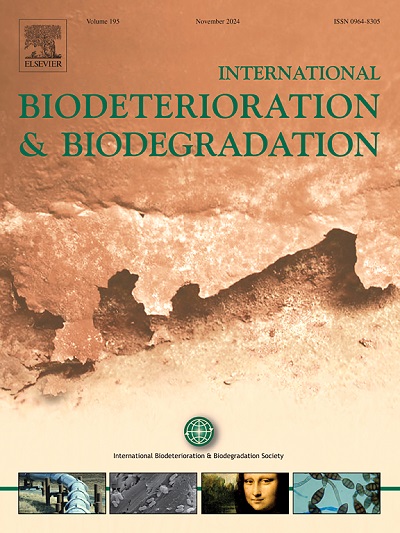优化的Fe/Cu阴极催化剂电催化氧化双酚A:生物毒性和生物电fenton系统的微生物群落分析
IF 4.1
2区 环境科学与生态学
Q2 BIOTECHNOLOGY & APPLIED MICROBIOLOGY
International Biodeterioration & Biodegradation
Pub Date : 2025-05-17
DOI:10.1016/j.ibiod.2025.106126
引用次数: 0
摘要
生物电fenton (Bioelectro-Fenton, BEF)系统在污染物的可持续处理方面引起了人们的关注,但Fe/ cu基阴极催化剂的应用仍然受到不稳定性、金属浸出和潜在有毒副产物的限制。双酚A (BPA)是一种持久性和有毒的内分泌干扰物,其处理进一步挑战了废水修复。本研究利用响应面法优化了Fe/Cu阴极催化剂的制备条件,通过增加H2O2的生成、去除BPA、降低阴极内阻来提高BEF体系的性能。优化后的Fe/Cu双金属催化剂在11 h内对10 mg/L BPA的去除率达到99.76%,明显优于单金属催化剂的BEF (Fe和Cu的去除率分别为73.43%和58.51%)。与Fe和Cu催化剂相比,Fe/Cu催化剂的电荷转移电阻降低了61.79% ~ 63.09%。优化后的Fe/Cu催化剂可重复使用至8次循环,对BPA的去除率为73.34%,显示了其重复使用的潜力。阳极微生物群落分析结果显示出明显的变化,假单胞菌丰度从3.46%增加到51.76%,表明优化后的Fe/Cu催化剂促进了电活性微生物的富集,提高了系统性能。本文章由计算机程序翻译,如有差异,请以英文原文为准。

Electrocatalytic oxidation of bisphenol A using optimized Fe/Cu cathodic catalysts: Biotoxicity and microbial community analysis in bioelectro-Fenton systems
Bioelectro-Fenton (BEF) systems have attracted attention for sustainable pollutant treatment, but the application of Fe/Cu-based cathodic catalysts remains limited by instability, metal leaching, and potential toxic by-products. The treatment of bisphenol A (BPA), a persistent and toxic endocrine disruptor, further challenges wastewater remediation. This study uses the response surface method to optimize the preparation conditions of Fe/Cu cathode catalysts for enhancing the performance of BEF systems by increasing H2O2 generation, removing BPA, and decreasing the internal resistance of the cathode. The optimized Fe/Cu bimetallic catalyst applied to the BEF system exhibits 99.76 % removal of 10 mg/L BPA in 11 h, significantly outperforming the BEF with the monometallic catalysts (73.43 % and 58.51 % for Fe and Cu, respectively). The charge transfer resistance of the Fe/Cu catalyst is reduced by 61.79 %–63.09 % compared with that of the Fe and Cu catalysts. The optimized Fe/Cu catalyst is reused up to the eighth cycle with 73.34 % BPA removal efficiency, demonstrating its reuse potential. Microbial community analysis at the anode showed a marked shift, with Pseudomonas abundance increasing from 3.46 % to 51.76 %, suggesting that the optimized Fe/Cu catalyst promoted electroactive microbial enrichment and enhanced system performance.
求助全文
通过发布文献求助,成功后即可免费获取论文全文。
去求助
来源期刊
CiteScore
9.60
自引率
10.40%
发文量
107
审稿时长
21 days
期刊介绍:
International Biodeterioration and Biodegradation publishes original research papers and reviews on the biological causes of deterioration or degradation.

 求助内容:
求助内容: 应助结果提醒方式:
应助结果提醒方式:


